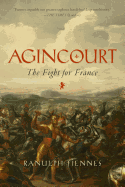
Sir Ranulph Fiennes (The Feather Men) has an impressive pedigree: he can trace his ancestry back to Charlemagne, through the Norman conquest of England in 1066 (one of his ancestors is depicted on the famous Bayeux Tapestry telling William the Conqueror to retreat from the Battle of Hastings, advice the future king ignored) and the Hundred Years' War between England and France (1337 to 1453). What makes Fiennes, an English explorer, an interesting choice to write about the Battle of Agincourt is his familial connection to the conflict. His ancestry split when the Normans invaded England--some stayed behind in Northern France while others followed William across the Channel. Thus when King Henry V faced off against the French near Agincourt village in 1415, Fiennes had family on both sides of the battle.
The Hundred Years' War came about thanks to complicated webs of intermarriage between Anglo-Norman and French dynasties. Fiennes's relatives implicated in the war are so numerous that he relies on italicizing names of relations, rather than the repetitive use of phrases like "my ancestor so-and-so." At times this chronicle of names veers into something only a genealogy junkie could love, but Fiennes is quick to tie his own family tree into a broader explanation of the geopolitical circumstances that led to Agincourt. His account of the battle itself is thrilling as any popular historical fiction, and he continues to the conclusion of the war, which raged for another 38 years. Agincourt, published 600 years after the battle, turns usually impersonal history into a family affair. --Tobias Mutter, freelance reviewer

